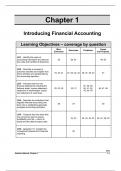Exam (elaborations)
Solutions Manual For Financial Accounting, 7th Edition by Hanlon, Magee, Pfeiffer.
- Course
- Institution
Solutions For Financial Accounting, 7th Edition by Michelle Hanlon, Magee, Pfeiffer, Dyckman. Financial Accounting, 7e solutions. Hanlon 7e solutions manual ISBN: 9781618534316.
[Show more]



